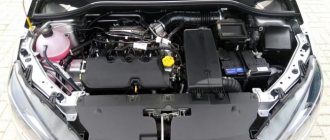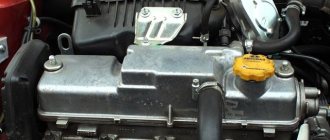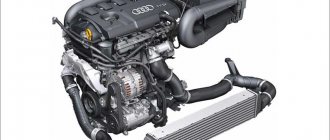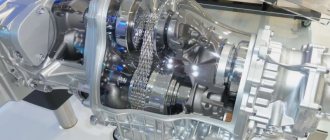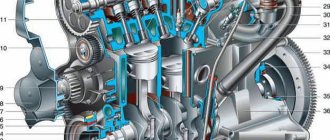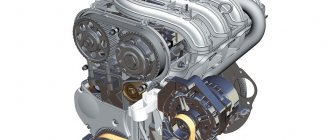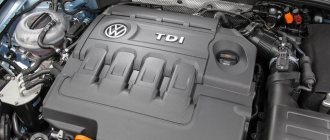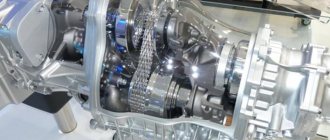Initially, the VAZ 21126 engine became the second version of the base engine 2112. In the first modification, 21124, the volume was increased and Euro 4 standards were met, but the torque/power was reduced. The manufacturer AvtoVAZ needed a powerful engine with a minimum service life of 200,000 km, so version 21126 has 145 Nm of torque and 98 hp. With. power, specified operational life.
ICE 21126
Engine characteristics 21126
Motor 21126 is the second version of the basic ICE 2112 out of five existing ones (21124, 21127, 21128 and 21129). The main tasks of the developers in this case were:
- increase power;
- increase resource;
- maintain the Euro 4 protocol;
- keep production costs within reasonable limits.
Block marking
Lada Priora cars, the production of which began in the same year, needed an engine with such characteristics. An important feature of the internal combustion engine marked 21126 was the inclusion of imported spare parts - a lightweight connecting rod and piston group from Federal Mogul, a timing belt and rollers from Gates.
The engine diagram remains the same:
- in-line transverse for front-wheel drive;
- 16 valves and 2 camshafts according to the DOCH scheme;
- hydraulic compensators and phased injection;
- intake manifold combined with the receiver;
- exhaust catalyst with integrated catalytic converter.
Engine assembly
The initial boost of the engines from version 21124 was carried out by the manufacturer, providing a potential of at least 50 hp. With. power for self-tuning.
Taking into account the above, the technical characteristics of the AvtoVAZ 21126 power drive version are as follows:
| Manufacturer | AvtoVAZ |
| Engine brand | 21126 |
| Years of production | 2007 – … |
| Volume | 1597 cm3 (1.6 l) |
| Power | 72 kW (98 hp) |
| Torque moment | 145 Nm (at 4000 rpm) |
| Weight | 115 kg |
| Compression ratio | 11 |
| Nutrition | injector |
| Motor type | in-line |
| Injection | distributed electronically controlled |
| Ignition | coil for each spark plug |
| Number of cylinders | 4 |
| Location of the first cylinder | TVE |
| Number of valves on each cylinder | 4 |
| Cylinder head material | aluminum alloy |
| Intake manifold | combined with receiver, polymer |
| An exhaust manifold | catalyst |
| Camshaft | 2 pcs., marks on pulleys are offset by 2 degrees |
| Cylinder block material | cast iron |
| Cylinder diameter | 82 mm |
| Pistons | lightweight, manufacturer Federal Mogul |
| Crankshaft | from 11183 |
| Piston stroke | 75.6 mm |
| Fuel | AI-95 |
| Environmental standards | Euro 4 |
| Fuel consumption | highway – 6 l/100 km combined cycle 7.2 l/100 km city – 9.8 l/100 km |
| Oil consumption | maximum 0.1 l/1000 km |
| What kind of oil to pour into the engine by viscosity | 5W-30 and 10W-40 |
| Which engine oil is best by manufacturer | Liqui Moly, LukOil, Rosneft, Mannol, Mobil, Castrol |
| Oil for 21126 according to composition | synthetics, semi-synthetics |
| Engine oil volume | 3.5 l |
| Operating temperature | 95° |
| Motor life | declared 200,000 km actual 300,000 km |
| Adjustment of valves | hydraulic compensators |
| Cooling system | forced, antifreeze |
| Coolant quantity | 7.8 l |
| water pump | TZA |
| Candles for 21126 | BCPR6ES from NGK or domestic AU17DVRM |
| Gap between spark plug electrodes | 1.1 mm |
| Timing belt | Dyco, width 22 mm, service life 40,000 km |
| Cylinder operating order | 1-3-4-2 |
| Air filter | Nitto, Knecht, Fram, WIX, Hengst |
| Oil filter | catalog number 90915-10001 replacement 90915-10003, with check valve |
| Flywheel | from 2110 |
| Flywheel mounting bolts | box MT – M10x1.25 mm, length 26 mm, groove 11 mm box AT – M10x1.25 mm, length 26 mm without groove |
| Valve stem seals | code 90913-02090 inlet light code 90913-02088 exhaust dark |
| Compression | from 13 bar, difference in adjacent cylinders maximum 1 bar |
| XX speed | 800 – 850 min-1 |
| Tightening force of threaded connections | spark plug – 31 – 39 Nm flywheel – 62 – 87 Nm clutch bolt – 19 – 30 Nm bearing cap – 68 – 84 Nm (main) and 43 – 53 (rod) cylinder head – three stages 20 Nm, 69 – 85 Nm + 90° + 90° |
The manufacturer has a manual with step-by-step maintenance and repair operations, which describes the parameters and maintenance regulations. Since the service life is declared taking into account the assembly line with parts from foreign manufacturers, it is recommended to carry out major repairs using original spare parts. The quality of domestic companies does not reach the level of international brands Gates and Federal Mogul.
Are the valves bending?
In Lada Priora cars, even in a 16-valve 126 power unit, valves can often bend. The reasons causing this defect lie in non-compliance with operating rules, in case of violation of the regulations for replacing the following components and parts:
- rollers;
- timing belt;
- water pump.
If one of the listed components breaks down, the pistons, exerting mechanical stress on the valves, can bend them. The design features of the engine are the reasons why the engine can bend valves. Deformation of the valves necessitates a major overhaul of the Priora engine.
To avoid this defect, the car owner needs to timely check the timing elements. Of particular importance is the belt, which is subject to thorough inspection after 50 thousand kilometers. When checking, the following faults are excluded:
Disadvantages and advantages
The indicated characteristics of the engine and real experience in its operation since 2007 allow us to judge the shortcomings:
- a broken timing belt is fraught with major repairs;
- due to the need for high-quality lubrication, the vehicle operating budget increases;
- The cost of overhaul is affected by the high price of the timing belt and rollers, ShPG of foreign manufacturers, even if it is made by hand.
On the other hand, the motor has much more advantages; they outweigh the indicated disadvantages:
- lack of constant valve clearance adjustments;
- increase in service life, power and torque;
- reduction of noise and vibrations;
- economical fuel and oil consumption;
- compliance with Euro-4 standard.
Metal gaskets last longer, and the timing belt does not need to be constantly tightened and monitored for accidental slippage when oil gets in.
Peculiarities
In 2007, the AvtoVAZ concern pleased the general public because they launched the VAZ-21126 power unit into production. Initially, the internal combustion engine was located under the hood of the Lada Priora. But after that, it turned out that it is so reliable that it can be used on other models of manufacturers without any problems.
In the future, manufacturers even began to use this power unit as an experimental base in order to develop sports modifications. The most striking example was the NFR version, which was installed on the Lada Kalina. It was also used as a basis for other engines that were distinguished by their modernity, for example the VAZ-21128.
Already according to the classics, the engine was assembled in an in-line layout with four cylinders and without a turbine. A working volume of 1.6 liters made it possible to provide quite impressive technical characteristics of the VAZ 21126 engine in the form of a power of 98 horsepower, while its torque is 145 Nm.
The VAZ 21126 engine block was made of cast iron. The lower part of the block houses 5 crankshaft supports, which have liners made of alloy and aluminum. This time the height of the cylinder block was 197.1 millimeters. The crankshaft was cast from cast iron with increased strength. The design of the VAZ 21126 engine was such that it required a piston stroke of 75.6 millimeters, so the crank radius had to be increased in comparison with the VAZ-2112 power unit.
Aluminum was used to make the pistons, and as always they included two compression rings and one oil scraper ring. For greater efficiency, manufacturers decided to reduce the weight of the pistons and also install oil nozzles to cool the bottom. Engines produced after 2022 had a deep counterbore on the bottom, protecting the valves from contact with the piston if the timing belt breaks.
Aluminum was the main material for making the cylinder head. The upper part of the cylinder head serves as a place for installing two camshafts and 16 valves equipped with hydraulic compensators. This solution eliminated the periodic need to manually adjust the valves. Aluminum is also used to make the head cover.
The engine cooling system of the VAZ 21126 is made in a standard design, only it has an electric fan for blowing the radiator. The lubrication system is made in a combined design, so the lubricating fluid is supplied to the rubbing surfaces under pressure and sprayed.
Manufacturers have made certain modifications to the fuel system. The fuel rail has now begun to be made of stainless steel, and there is no return fuel drain. A pressure regulator was installed in the fuel pump module. As an addition, a vapor recovery system equipped with a carbon absorber was placed in the system, which made it possible to limit the release of fuel vapors into the environment.
The ignition system uses individual coils that are installed on each spark plug. Thanks to this solution, the design completely eliminates high-voltage wires, eliminating the possibility of their breakage.
The use of data and other modern solutions during the development of the power unit made it possible to guarantee its efficiency and unpretentiousness, while maintaining fairly good technical characteristics in its class. In general, many people really call the 126 engine one of the best in the entire history of the concern.
What cars was it in?
Immediately after its release, AvtoVAZ management began using the 21126 engine to power the following Lada models:
- Priora - from 2007 to 2016, all trim levels;
- Kalina - from 2007 to 2013, Luxury equipment;
- Kalina-2 - since 2013, on cars with automatic transmission;
- Granta - since 2011, Norma and Luxury equipment.
Lada Granta
Currently, Priora engines are equipped with 21127 engines, which have become the next version of the development of the 21126 internal combustion engine. On the other two models - Kalina-2 and Granta, this engine is used mainly with the JF414 automatic transmission from the Japanese manufacturer Jatco.
Maintenance
To ensure the declared resource, engine 21126 must be maintained in accordance with the regulations below:
- after 10,000 km, change the engine oil with the appropriate filter;
- The battery, attachment belts and crankcase ventilation can withstand 20,000 km;
- The tank cap, antifreeze and cooling system hoses, fuel and air filters cannot overcome the 40,000 mileage mark;
- It is recommended to replace the oxygen sensor after 100,000 km, and the timing belt after 180,000 km.
Complex design solutions have been added to the internal combustion engine, so it is necessary to meet the deadlines for replacing consumables.
Problems
But despite the fact that the engine is praised quite strongly, and a lot of positive things are said about it, it is not without characteristic problems and breakdowns. Many owners often encounter certain types of malfunctions, which include the following:
- Until 2022, a broken timing belt on a VAZ 21126 engine led to a collision of valves with pistons. This entailed a bend, after which operation of the engine became impossible. After 2018, other pistons were used in the internal combustion engine design and the problem disappeared.
- The mass air flow sensor often fails, so engine owners are faced with floating speed. But you should not immediately purchase new sensors, since you should first try cleaning the idle air control and throttle valve.
- Often the thermostat can also fail. This entails the problem of overheating. As a rule, in cold weather the car cannot reach operating temperature, and in the summer it begins to boil, so it is worth paying attention to this detail.
- Electrical failures are also common for this power unit. This can lead to quite serious consequences in the form of a burnt-out starter, broken ignition coils, fuel pressure regulator or electronic engine control unit under the index 1411020.
- You can also notice that the engine has started to run on three cylinders. First, you should pay attention to each coil and spark plug, and if everything is in order with them, then you need to remove the injectors. As practice shows, they can become clogged and simply need to be washed.
- Hydraulic compensators can create unpleasant knocking noises from under the hood while the engine is running. But if no complaints are noticed in them, then you should prepare for a major overhaul, since connecting rods or pistons may knock.
Malfunctions, causes, elimination
Since the 21126 engine is a 16-valve front-wheel drive design with an overhead camshaft position, it is prone to characteristic breakdowns:
| No startup when crankshaft rotates | 1) ignition coils are faulty 2) failure of electronic control 3) DPKV breakdown 4)fuel system malfunction | 1) Repair or replacement 2) flashing or replacing controllers 3) replacing the crankshaft position sensor 4) replacing the pressure regulator, cleaning the fuel module, injectors and ramp |
| The engine won't start | 1) cold 2) warmed up | 1) recharging the battery, cleaning the power system, replacing the coolant temperature sensor, replacing injectors, repairing the fuel management system 2) in addition to the above, replacing the air filter |
| The speed is floating XX | 1) vacuum hose connections 2) cylinder head gasket 3) clogged air filter | 1) replacing or tightening clamps 2)use a new gasket 3) cleaning or replacing the cartridge |
| Misfire in XX mode | 1)low compression 2) injector failure 3) failure of the ignition coils 4) faulty spark plugs | 1) replacing rings; valve stem seals2) installation of new injectors 3)repair or replacement 4) gap adjustment or replacement |
If you follow the requirements of the operating instructions and maintenance regulations, these troubles can be avoided.
Work resource
The manufacturer states that the 126 by 16 valve engine can operate stably for 200 thousand kilometers. After this limit, the power plant requires major overhaul. But do not forget that AvtoVAZ is a real lottery; for some Priora owners, the engine caught a wedge at 2 thousand. But if you take care of your Lada car, regularly perform maintenance and replace damaged components, then you can safely count on a service life of 150-200 thousand km.
The resource of the power plant is influenced by many factors, here are some of them:
- Overheating . Running the engine on a Priora at elevated temperatures significantly reduces its service life. The operating temperature, which we will talk about in the next section, must be maintained at the same level.
- Fuel . The instruction manual indicates what kind of gasoline should be poured into engine number 126 with 16 valves. It is also recommended to visit only trusted gas stations that will not fill you with diluted fuel.
- Engine oil . Everything is simple here - change the lubricant in a timely manner and buy high-quality oils, then the service life will be 150-200 thousand km. For the 16 valve unit 126, semi-synthetics (Lada recommendation) and synthetics are suitable. The oil needs to be changed once a year or every 15 thousand kilometers; as you can see, the fluid does not have a long service life.
Engine tuning
By default, engine 21126 is already boosted by AvtoVAZ designers. However, the power of the internal combustion engine can be further increased by tuning. It is enough to take into account the following nuances:
- The ShPG is already as lightweight as possible, but you can bore the cylinders and use a piston group of a larger diameter;
- tuning of the gas distribution mechanism is most often used - split gear and lightweight Nuzhdin camshaft;
- tuning of the intake and exhaust systems is used - 4 throttles for each cylinder, a “spider” exhaust tract diagram, respectively.
Tuning 21126
To turbocharge the engine, a high modernization budget will be required, the engine life will noticeably decrease and scheduled maintenance will become more frequent.
Thus, ICE 21126 has become an improved version of the previous modification 21124. The power characteristics and service life have increased, the design of the timing drive has been simplified, and the replacement of the belt and rollers has been made easier.
If you have any questions, leave them in the comments below the article. We or our visitors will be happy to answer them
